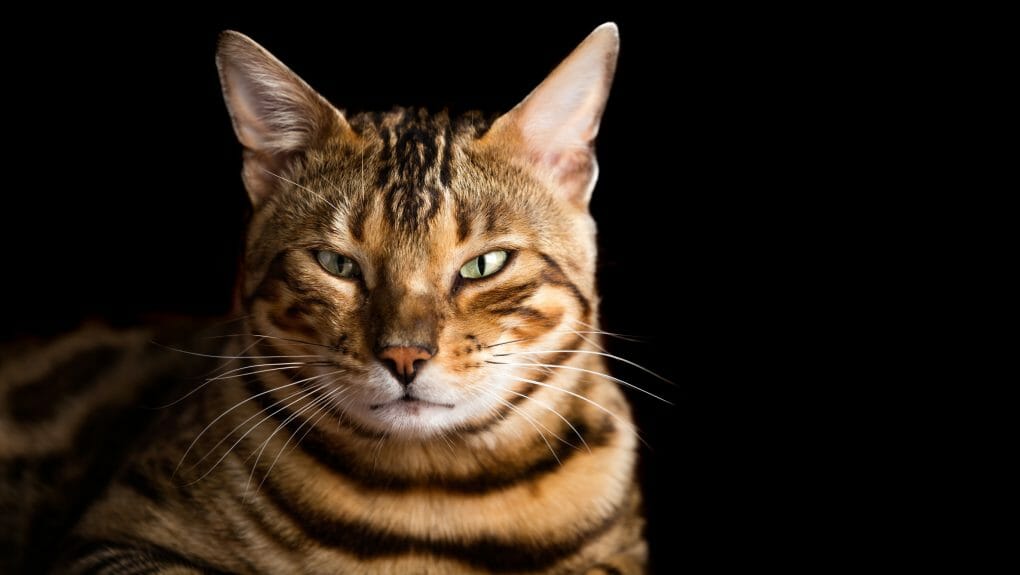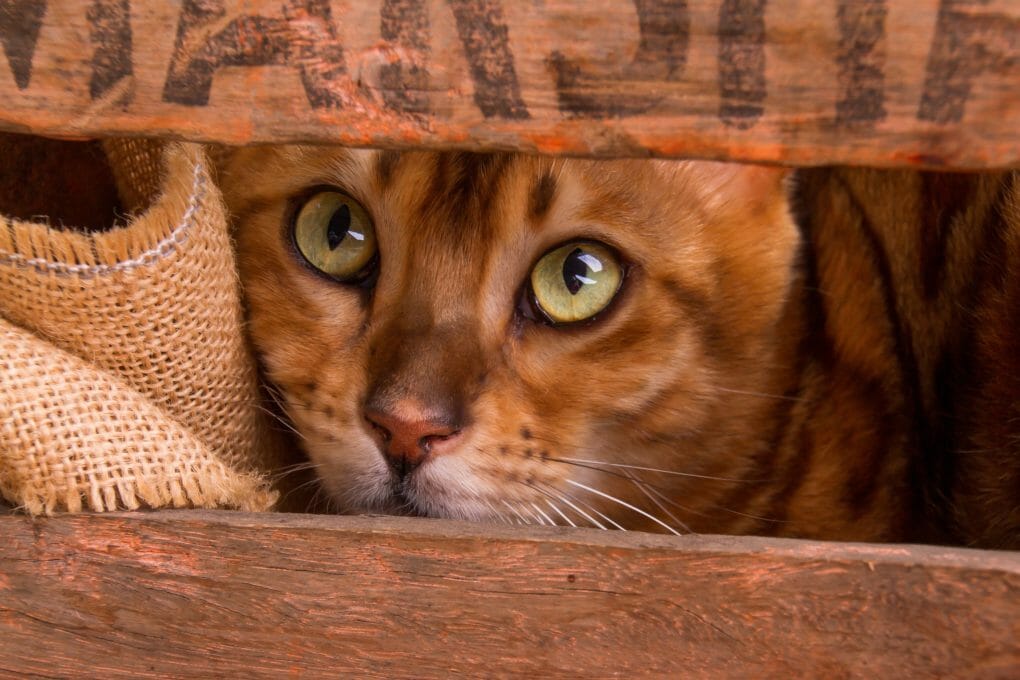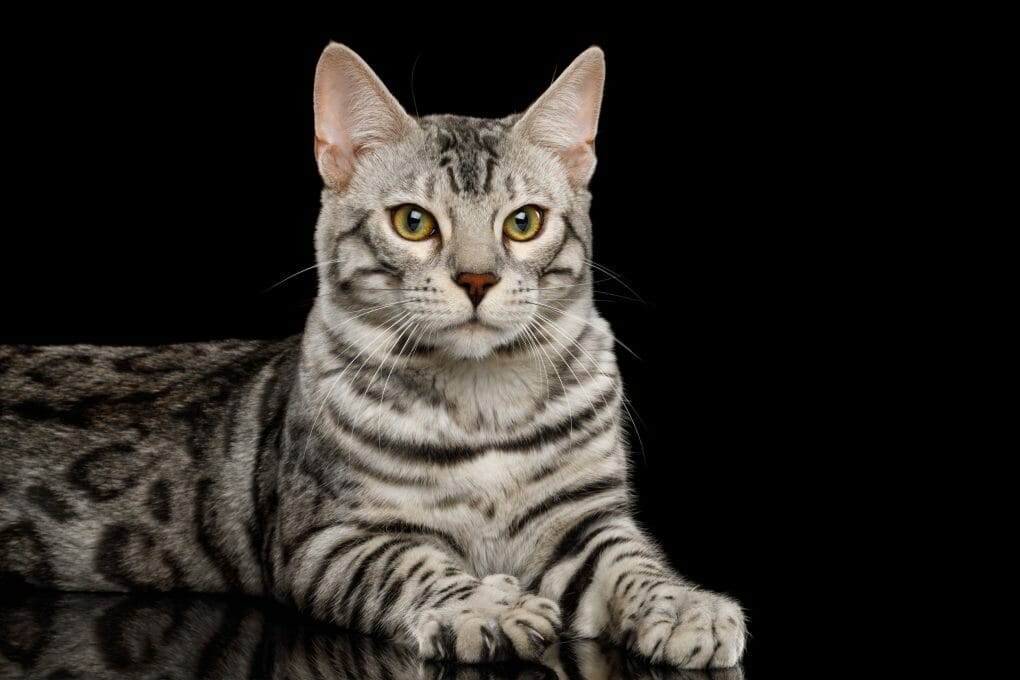Where Are Bengal Cats From: Understanding the Characteristics This Breed Got From Its Ancestors
Bengal cats were developed in the United States by crossbreeding the Asian Leopard cat and short-haired domestic cat breeds. The breed was first developed by Jean Mill, a conservationist seeking to protect the Asian Leopard cat. This resulted in creating a domestic cat with the rugged appearance of an Asian leopard cat but the temperament of a domestic cat.
Table of Contents
Characteristics of Bengal Cats As Passed Down by Their Ancestors
Appearance
Bengal cats have a distinctive appearance characterized by their wild-looking coat and athletic build. They have short, sleek fur, usually brown with black barring the chest. Their coat can range from brown to gold, some cats have a silver or “snow” coloration, and their soft glossy fur is easy to take care of.


Bengal cats are big-eyed felines with long, slender bodies and elongated heads. They have round eyes that are typically bright green or gold in color. They also have a muscular, athletic build, long, slender legs, and powerful, agile bodies. They enjoy climbing and playing.
Intelligent and Playful That Requires Plenty of Activity
Bengals have energetic and active personalities, so they require plenty of physical and mental stimulation to keep them happy and healthy. They need plenty of exercise – they love to play fetch! In addition to this essential activity, Bengals enjoy playing with cat toys and chasing each other indoors.
As such, they need at least a few hours of daily walking or running outside if you want them to stay healthy and happy. If you have a Bengal cat comfortable wearing a harness and leash, you can take them for a walk around your neighborhood. This can provide them with the opportunity to explore and exercise.
Enjoys Human Companionship
Most Bengal cats enjoy human companionship and can live healthy lives with enough exercise and attention. On average, Bengals have a 12 to 16 years lifespan, but this number can vary depending on factors like health and environment.
Bengal cats are known for their energetic and playful personalities and often form strong bonds with their human companions. Many Bengal owners describe their cats as more like dogs than cats regarding their affection and attachment to humans.
Bengal cats are intelligent and curious and love exploring and playing. They often enjoy interacting with their humans, seeking attention and affection, playing games like fetch, or participating in interactive play sessions.
Bengal cats are generally friendly and social and do well in households with multiple people or other pets. However, it is essential to remember that every cat is unique and will have its personality and needs. Some Bengal cats may be more independent and aloof, while others crave more attention and interaction.
Socialization With Other Cats
Bengal cats are called ‘cuddle cats’ because they love socializing and spending time with other felines. They make great house pets thanks to their friendly personalities and affectionate nature. They enjoy playing with each other in various games and activities, which is why Bengals are often kept in households with other cats.
Temperament
Bengal cats have temperamental personalities, making them difficult to handle at times; however, they are good pets for patient and understanding people – they require little attention overall!
Legal Restrictions in Owning Bengal Cats


There are a few states where Bengal cats are not legally allowed. This includes New York and Hawaii. Breeders and cat owners in these countries should be aware of the legal restrictions in their respective countries before making a sale or purchase. So if you’re looking to buy a Bengal cat – or any other exotic pet – be sure to research this legality before getting one, as there may be local ordinances or regulations that apply to the ownership of certain breeds of cats, including Bengals.
It is essential to check with your local authorities to see if there are any specific ordinances or regulations that apply to the ownership of cats in your area. It would help if you also were prepared to provide proper care, socialization, and training for your cat to ensure that it is well-behaved and well-adjusted.
In some cases, local authorities may have regulations for the ownership of cats considered “exotic” or “wild.” These regulations may be put in place due to concerns about the potential for these cats to be more aggressive or dangerous than other breeds. However, no scientific evidence supports the idea that certain breeds of cats are inherently more aggressive or dangerous than others.
Common Health Issues of Bengal Cats
Bengal cats are prone to some health issues like cataracts and feline AIDS. Ensure you keep your Bengal cat healthy and happy by providing enough exercise and a nutritious diet.
Hypertrophic Cardiomyopathy
Hypertrophic cardiomyopathy is a heart condition that affects cats the most. It is commonly found in Bengal cats. It causes the heart muscle to become enlarged and thick. This can lead to several health problems, including cardiac murmur (a noise made when the cat’s heart beats), congestive heart failure, arrhythmia (abnormal heartbeat), and even death within a few months of diagnosis.
If not detected and treated early, HCM can be fatal. Many symptoms are associated with HCM, but the most common ones include shortness of breath, coughing, rapid breathing, exercise intolerance, and sudden death.
Currently, there is no cure for hypertrophic cardiomyopathy, but treatments are available to help improve the cat’s quality of life. These include medication or surgery to reduce the size of the myocardium or increase blood flow through it.
Early diagnosis is crucial for successful treatment. In some cases, medical treatments such as medication could also help reduce the level of stress on the myocardium.
Progressive Retinal Atrophy
If you’re a cat lover, you’ll want to know about the Bengal progressive retinal atrophy (PRA-b) condition. This genetic eye disease affects cats and causes them to lose their vision as they age gradually.


Although there is no cure for PRA-b, you can still manage it effectively with early diagnosis and treatment. If left untreated, PRA-b will lead to blindness in affected cats. Fortunately, cat owners can help prevent this by routinely checking their cat’s eyes for signs of the condition and getting them treated as soon as possible if any are detected.
Erythrocyte Pyruvate Kinase Deficiency (Pk-Deficiency or Pk-Def)
Erythrocyte pyruvate kinase deficiency (PK-deficiency or PK-def) is a rare genetic disorder in cats that results in low levels of erythrocyte pyruvate kinase enzyme. This can lead to problems with red blood cell formation and anemia, headaches, seizures, and even coma.
There are treatments available, but getting help as soon as possible is essential as the condition can rapidly progress if left untreated.
Luxating Patellas
Luxating patellas, or discoordination syndrome, is a common health issue in Bengals. This condition is caused by an imbalance in the patella tendon – a connective tissue that helps move the knee joint. The most common sites for luxating patellas are the front and rear legs. Treatment typically involves physical therapy and wearing a brace to support the knee joint.
Kidney Issues or Renal Failure
Bengals are one of the breeds that are particularly prone to developing kidney disease or renal failure due to the high protein levels in their diet – which can overload the kidneys and lead to health problems.
You can do a few things as a cat owner to help prevent this from happening, such as feeding them a balanced diet and ensuring they get regular exercise. If your cat develops kidney disease, it’s essential to treat them as soon as possible so it can enjoy a long healthy life.
